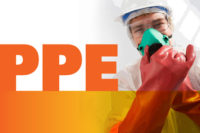Protecting the eyes & face
The challenge continues to persuade workers to wear eye/face protection. Everyone wants to look stylish with modern, up-to-date and sporty eyewear. However, the variety of head shapes for male and female workers presents the problem of large head/small head and everything in between. Then consideration must be given to glass or goggle, work area, presence of debris in the air and harmful rays, which leads to the various types of lens tint. All these factors figure in determining the style, fit and function of eye/face protection.
Protection for the eye comes in various forms or styles. Almost everyone required to utilize eyewear in his or her job function wants a mirror to “check out” his or her appearance in a particular glass.
Face protection is basically a shield of the appropriate type to protect the face. Depending on the protection required, the face shield could be PETG, polycarbonate or acetate and fairly basic in design. ANSI standards require face protection to be at least 1 mm (.040 in.) in thickness.
Broadly, OSHA regulations as set forth in Standard 29 CFR, 1910.133, states, “The employer shall ensure that each affected employee uses appropriate eye or face protection when exposed to eye or face hazards from flying particles, molten metal, liquid chemicals, acids or caustic liquids, chemical gases or vapors, or potentially injurious light radiation.”
Each facility may have additional requirements particular to the plant environment. While in most cases 1 mm (.040 in.) thickness meets the basic ANSI requirement, additional circumstances might guide the facility to a thicker visor for adequate protection. Lens tint might also factor into proper protection in both an eyeglass and face protector.
Above all, common sense should rule supreme. Eye/face protection is required to preserve the safety of each and every worker.
Addressing excuses
There are many more excuses for not wearing eye/face protection than there are for wearing eye/face protection. Among the most common excuses are: it is too hot to wear, the protection fogs up thus limiting wear time, the protection causes irritation and discomfort, cannot focus through the lens or visor and, probably the most common excuse, “I just do not want to wear it!” Supervisory personnel, safety engineers and others responsible for worker safety should have plausible reasons to encourage workers to continually wear eye/face protection. Air circulation can certainly ease many complaints about heat and fogging problems. Wipes and sprays can ease fogging conditions along with eyewear and shields that are coated with an anti-fog agent. Commonly, a treated lens or shield is more expensive, but if it solves a problem, the cost is justified.
Basically, if eye/face protection is needed, there should be no objection that a worker can state that should prevent the worker from wearing such protection.
Consequences of non-compliance
Consequences of non-compliance with established policy could result in minor injuries such as particles in the eye, scratches or abrasion on the face and in some cases, burns to the eye or face. More serious injuries could involve projectiles lodged in the eye or face, severe burns to the eye or face from molten matter or chemical/acid splash. It is not beyond the realm of believability that any contact with the eye or face from an errant chip or particle could cause the most serious of injuries — death. While that possibility is rather extreme, it can certainly happen.
The potential for any injury — minor, severe or fatal — should be the overriding criteria for convincing workers to properly position eye/face protection while performing duties that require that level of protection.
Obviously, cost becomes a factor in consideration of style, fit and function. But what is the cost of any injury that may result because workers simply will not continue to utilize adequate protection for eyes or face? Get workers to continue to wear protection for their safety, thus avoiding lost time, medical expense to the company and possible fines from regulating authorities.

